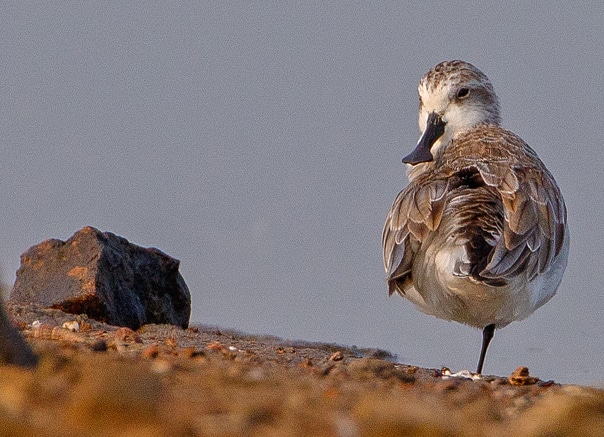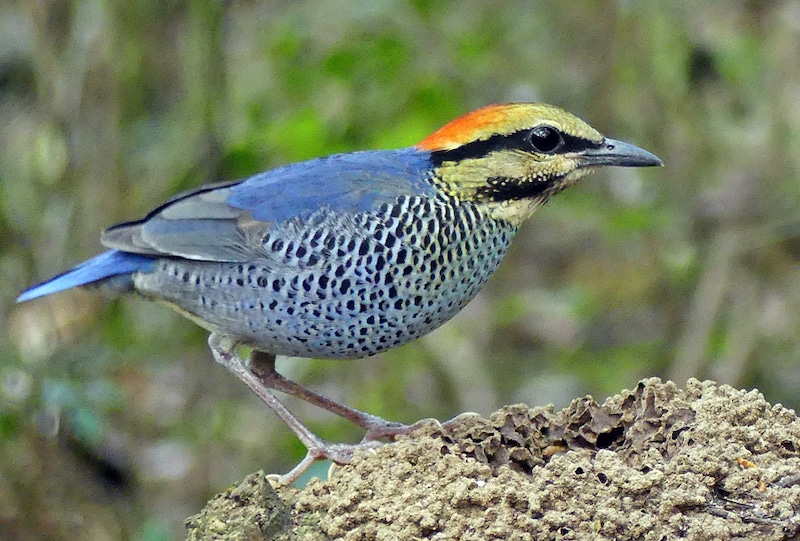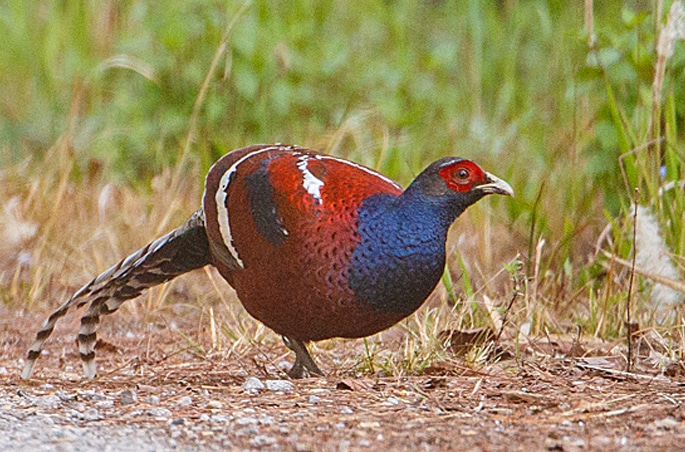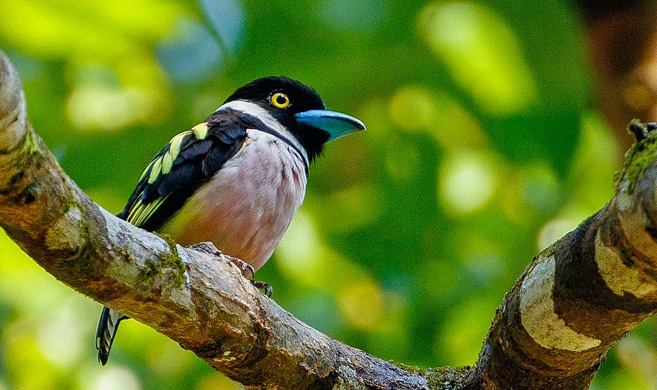By Andrew Walker, Birding Ecotours
Thailand is one of the best birding destinations in all Southeast Asia. It has a bird list of nearly 1,100 species, made up by some seriously spectacular resident birds from some of the best-looking families on earth, such as pittas, broadbills, trogons, kingfishers, and hornbills, as well as (during the northern winter months), some of the most highly sought-after shorebirds on the planet, headlined by one of the best, as well as mix of easy-to-identify colourful migrant passerines, and some that take a little bit more patience and skill to work though, namely the Phylloscopus leaf warblers.
As with most birdwatching destinations, it is prudent to have a strategy to make the most out of the country and its birds. From a birding point of view, Thailand splits perfectly into three fairly distinct regions (north, central, and south Thailand), each offers a bit of overlap (which helps with familiarity), but each offers birds not found elsewhere in the country. The three sections are explored below.

Spoon-billed Sandpiper (Calidris pygmaea) is one of the most highly sought-after shorebirds in the world and Central Thailand during the northern winter offers a great opportunity to see it.
Bangkok in Central Thailand is the main gateway to this fantastic country so it makes sense to start here, with a circuit taking in Pak Thale, Kaeng Krachan, and Khao Yai, which offers an amazing shorebird (wader) spectacle, as well as some great forest birding. Top of the list of most-wanted is always going to be the Critically Endangered and unique Spoon-billed Sandpiper (Calidris pygmaea), one of the rarest in the world, but there are other important ‘world birds’ possible here too, such as White-faced Plover (Charadrius dealbatus) – recently elevated to full-species status, Nordmann’s Greenshank (Tringa guttifer), Asian Dowitcher (Limnodromus semipalmatus), and Chinese Egret (Egretta eulophotes) to name a few. It is not all about shorebirds though (although it is possible to see 40 species in a weekend!), with the forests in this region being incredibly rich with pittas, broadbills, and pheasants like Silver Pheasant (Lophura nycthemera), Blue Pitta (Hydrornis cyaneus), Silver-breasted Broadbill (Serilophus lunatus), Long-tailed Broadbill (Psarisomus dalhousiae), along with many other top target birds like Coral-billed Ground Cuckoo (Carpococcyx renauldi), Ratchet-tailed Treepie (Temnurus tmenurus), Wreathed Hornbill (Rhyticeros undulatus), and so many more babblers, bulbuls, flycatchers, and laughingthrushes!

Blue Pitta (Hydrornis cyaneus) giving great views in central Thailand. The country is a fantastic location to see several representatives of this much desired family of brightly coloured gems of the forest.
Flying one-hour north from Bangkok to the ancient city of Chiang Mai into Northern Thailand, one is suddenly in a mountain world with delightful resident birds like Mrs. Hume’s Pheasant (Syrmaticus humiae), Giant Nuthatch (Sitta magna) which is seriously impressive and huge, but getting rarer by the year, Himalayan Cutia (Cutia nipalensis), White-crowned Forktail (Enicurus leschenaulti), Black-headed Woodpecker (Picus erythropygius) – probably one of the best-looking in the world, Spectacled Barwing (Actinodura ransayi), and Spot-breasted Parrotbill (Paradoxornis guttaticollis) to give a small sample.

Mrs. Hume’s Pheasant (Syrmaticus humiae) is one of the top targets for birdwatchers visiting northern Thailand. This secretive bird of the mountain pine forests is classified as Near-threatened by BirdLife International, factors such as habitat loss and climate change are likely to be behind this.
While birding in the amazing forests and rice paddies here it is possible to connect with some excellent migrant birds like the Critically Endangered (BirdLife International) Yellow-breasted Bunting (Emberiza aureola), the glorious trio of Ultramarine Flycatcher (Ficedula superciliaris), Himalayan Bluetail (Tarsiger rufilatus), and Siberian Rubythroat (Calliope calliope) along with plenty of the headache-inducing (for those not in the know!) Phylloscopus warblers, numerous thrushes, flycatchers, and if you are very lucky the incredibly rare Baer’s Pochard (Aythya baeri). There is also a Pied Harrier (Circus melanoleucos) roost in this part of Thailand that is mind-blowing and is a must-see too. The photo opportunities in Northern Thailand are excellent and there is always the feeling of turning up something ultra-rare for the country!

Numerous migrant passerines spend the winter in northern Thailand, many of them are rather spectacular, like this male Siberian Rubythroat (Calliope calliope), and add to the spectacle of the gorgeous resident birds for visiting birders.
An hours’ flight south from Bangkok to the city of Phuket in Southern Thailand grants access to a whole different world of birds, like gorgeous kingfishers, pittas, broadbills, and hornbills, as well as many bulbuls, babblers, and spiderhunters. The climate here is wetter and more humid than that further north and the coast is cloaked in mangrove forests and specialties abound such as Rail-babbler (Eupetes macrocerus) – a monotypic family, and some pretty beautiful and much sought-after birds like Malayan Banded Pitta (Hydrornis irena), Mangrove Pitta (Pitta megarhyncha), Green Broadbill (Calyptomena viridis), Black-and-yellow Broadbill (Eurylaimus ochromalus), Scarlet-rumped Trogon (Harpactes duvaucelii), Banded Kingfisher (Lacedo pulchella), and Red-bearded Bee-eater (Nyctyornis amictus).

The jungles of southern Thailand are full of drab, brown bulbuls and babblers, but they are also alive with colourful broadbills, like this Black-and-yellow Broadbill (Eurylaimus ochromalus), kingfishers, trogons, malkohas, leafbirds, flowerpeckers, and sunbirds.
A fantastic way to explore the forests in the south is by boat, doing so often allows for great and close-up view of the often-secretive hornbills, with species like the Critically Endangered (BirdLife International) Helmeted Hornbill (Rhinoplax vigil), and other spectacular examples of this great family, such as White-crowned Hornbill (Berenicornis comatus), Bushy-crested Hornbill (Anorrhinus galeritus), and Great Hornbill (Buceros bicornis) all possible. Exploring the rivers may also provide opportunities for Buffy Fish Owl (Ketupa ketupu), Lesser Fish Eagle (Haliaeetus humilis) and the secretive Crested Jay (Platylophus galericulatus) and is a really great way to see the forest and its inhabitants.

There are 13 species of hornbill in Thailand and 12 of them are of global conservation concern (BirdLife International), including this White-crowned Hornbill (Berenicornis comatus). The south of the country is great for observing them.
Thailand offers many great birds and birding experiences, it is a highly recommended destination whether it be a first or a tenth visit to Asia. The country is blessed with great infrastructure, good hotels and nature lodges, impressive landscapes, warm and friendly people, and excellent food. Come and see for yourselves…
All photos © Andrew Walker
